![]()
![]()
![]()
Use LEFT and RIGHT arrow keys to navigate between flashcards;
Use UP and DOWN arrow keys to flip the card;
H to show hint;
A reads text to speech;
12 Cards in this Set
- Front
- Back
- 3rd side (hint)
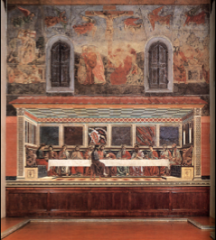
|
Castagno,
Last Supper, 1450 |
Rivalry between Castagno and Veneziano; possibly killed jhim according to Visari
|
|

|
Veneziano,
St. Lucy Altarpiece, 1447 |
|
|
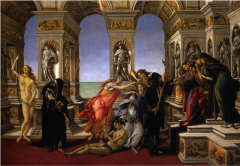
|
Botticelli,
Calumny of Apelles, 1498 |
1. Small painting,but full detailed
2. Recreation of a lost picture from antiquity, that was created by Apelles who took Calumny, Slander, as his subject. Only exists through verbal descriptions, carried out by well known authors like Lucian 3. Botticelli was illiterate; someone would have told him the story and he would illustrate it 4. Why did he make this? not sure if he made it for anyone, might have been a personal challenge. 5. setting: Background full of inset architectures, all of which are seen around florence |
|
|
Calumny of Apelles Imagery
|
1. Ruler, generic figure of authority sits on the right, his head being filled with foolishness by the woman beside him: shown through his donkey ears
2. Ruler talks to a poorly dressed man who is the personification of Envy; he is consumed by a disease and is being eaten inside out 3. Woman in white, is the personification of Calumny/slander, and has a man by the hair who is begging for freedom; the victim of slander; unjust punishment 4. Other two women who are accompanying slander; Fraud and decete/conspiracy. they are braiding beautiful ornaments into Calumny's hair to make her look beautiful; the beauty of rhetoric can really mask ugly motifs 5. Behind this figure we have this androgynous personification of repentance; covering her face in shame towards final character 6. Final naked female, pointing up towards sky is the personification of truth; truth will reign supreme 7. This image speaks on two levels: the personification of spoken rhetoric and the seductivity of images |
|
|
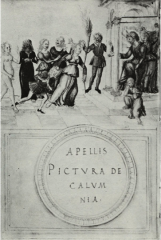
|
Bartolomeo della Fonte,
Calumny of Apelles, 1470 |
1. Copy of Lucians text by Fonte, included illustrations of the Calumny
2. Was available to Botticelli; large influence on the imagery the artist later used. |
|
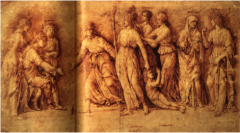
|
Mantegna,
Calumny of Apelles, 1504 |
1. Same characters of the two previous images of Apelles
2. Very likely that he never saw Botticelli's version due to substantial differences in how he sees the characters. 3. Similarities: personification of Truth are similar, through the pointing upwards motion. Fraud and Deceit both are ornamental figures that can lead our thoughts astray through beauty 4. Differences: Truth is more classic represntation, loral arround head, clothed. Shows the victim of Slander as a child, innocence. Botticelli diverts from this |
|

|
Mocetto,
Calumny of Apelles, 1506 |
1. Pretty much a copy of Mantegna's drawing
2. changes setting to venice (can see Verrocchio's equestrian monument to bartholomeo Calleoni) |
|
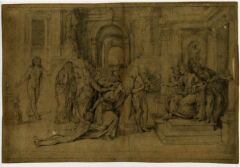
|
Raphael,
Calumny of Apelles, 1508 |
1. In some ways followinh Botticelli's ideas; theme of envy
2. similarities: truth is similar, pointing and naked; 3. Might have been interested in envy and rivalry because of his rivalry with Michelangelo |
|

|
Mantegna,
Battle of the Sea Monsters, 1475 |
1. Unusual subject matter; not very many sources for this imagery
2. possibly drawn from tales of greek mythology of Telchines, mythical sea monsters who were famous artists known for their spiteful, rancorous fighting amongst one another; gods are annoyed and they are cast into the swamps, to live amongst monsters. they continue to fight 2. reference in the background to neptune or poseidon, who is turned away from them in disgust of their envy and jealousy 3. Speaking of the jealousy among artists of hist time. |
|
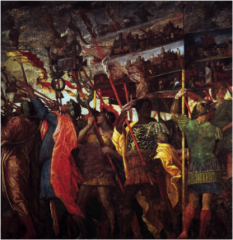
|
Mantagna,
the triumphs of Caesar, 1500 |
1. one of a series of canvases that focuesed on the triumphs of caesar
2. opportunity to recreate an a visual format a verbal recount of ancient roman history |
|
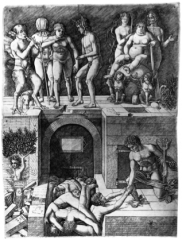
|
School of Mantegna,
Virtue in Flames and Deserted Virtue, 1500 |
1. Woman surrounded by different personifications of evil, leading her into temptation, where she is about to be pushed into a sestpool of other souls who were led astray by these ignorances; only those who realize the position they've found themselves in (young man on right bottom) can be saved
|
|
|
Comparison:
Botticelli, Calumny of Apelles and Mentagna, the Sea Monsters |
1. Botticelli: referred to one source
2. Mentagna: reference to a whole bunch of different, relatively unknown sources 3. Both critiquing artists during this time period |
|

